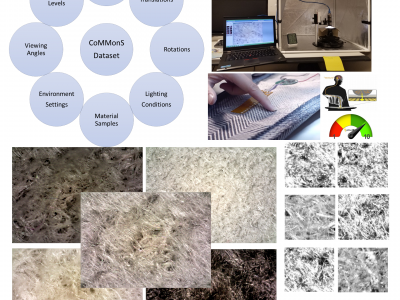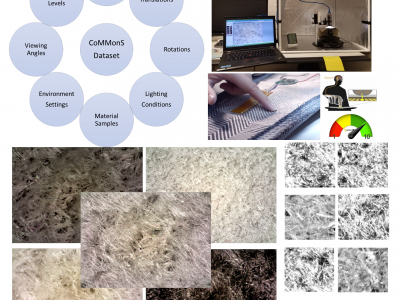Image Processing

This is the data for paper "Environmental Context Prediction for Lower Limb Prostheses with Uncertainty Quantification" published on IEEE Transactions on Automation Science and Engineering, 2020. DOI: 10.1109/TASE.2020.2993399. For more details, please refer to https://research.ece.ncsu.edu/aros/paper-tase2020-lowerlimb.
- Categories:
 1174 Views
1174 ViewsAs one of the research directions at OLIVES Lab @ Georgia Tech, we focus on recognizing textures and materials in real-world images, which plays an important role in object recognition and scene understanding. Aiming at describing objects or scenes with more detailed information, we explore how to computationally characterize apparent or latent properties (e.g. surface smoothness) of materials, i.e., computational material characterization, which moves a step further beyond material recognition.
- Categories:
 935 Views
935 ViewsAs one of the research directions at OLIVES Lab @ Georgia Tech, we focus on recognizing textures and materials in real-world images, which plays an important role in object recognition and scene understanding. Aiming at describing objects or scenes with more detailed information, we explore how to computationally characterize apparent or latent properties (e.g. surface smoothness) of materials, i.e., computational material characterization, which moves a step further beyond material recognition.
- Categories:
 268 Views
268 ViewsThe Costas condition on a permutation matrix, expressed as row indices as elements of a vector c, can be expressed as A*c=b, where b is a vector of integers in which no element is zero. A particular formulation of the matrix A allows a singular value decomposition in which the eigenvalues are squared integers and the eigenvalues may be scaled to vectors with all integer elements. This is a database of the Costas constraint matrices A, the scaled eigenvectors, and the squared eigenvalues for orders 3 through 100.
- Categories:
 443 Views
443 ViewsThis dataset contains the trained model that accompanies the publication of the same name:
Anup Tuladhar*, Serena Schimert*, Deepthi Rajashekar, Helge C. Kniep, Jens Fiehler, Nils D. Forkert, "Automatic Segmentation of Stroke Lesions in Non-Contrast Computed Tomography Datasets With Convolutional Neural Networks," in IEEE Access, vol. 8, pp. 94871-94879, 2020, doi:10.1109/ACCESS.2020.2995632. *: Co-first authors
- Categories:
 3813 Views
3813 Views
Objective: No data currently exist on the reproducibility of photographic food records compared to diet diaries, two commonly used methods to measure habitual dietary intake. Our aim was to examine the reproducibility of diet diaries, photographic food records, and a novel electronic sensor, consisting of counts of chews and swallows using wearable sensors and video analysis, for estimating energy intake.
- Categories:
 299 Views
299 Views
Supplementary material for the paper: 'Adaptive Block Compressive Imaging: towards a real-time and low complexity implementation'
- Categories:
 189 Views
189 Views
The supplementary files of our submitted TIFS paper: "CALPA-NET: Channel-pruning-assisted Deep Residual Network for Steganalysis of Digital Images".
- Categories:
 245 Views
245 Views
This aerial image dataset consists of more than 22,000 independent buildings extracted from aerial images with 0.0075 m spatial resolution and 450 km^2 covering in Christchurch, New Zealand. The most parts of aerial images are down-sampled to 0.3 m ground resolution and cropped into 8,189 non-overlapping tiles with 512* 512. These tiles make up the whole dataset. They are split into three parts: 4,736 tiles for training, 1,036 tiles for validation and 2,416 tiles for testing.
- Categories:
 375 Views
375 ViewsThis Dataset contains "Pristine" and "Distorted" videos recorded in different places. The
distortions with which the videos were recorded are: "Focus", "Exposure" and "Focus + Exposure".
Those three with low (1), medium (2) and high (3) levels, forming a total of 10 conditions
(including Pristine videos). In addition, distorted videos were exported in three different
qualities according to the H.264 compression format used in the DIGIFORT software, which were:
High Quality (HQ, H.264 at 100%), Medium Quality (MQ, H.264 at 75%) and Low Quality
- Categories:
 1115 Views
1115 Views



